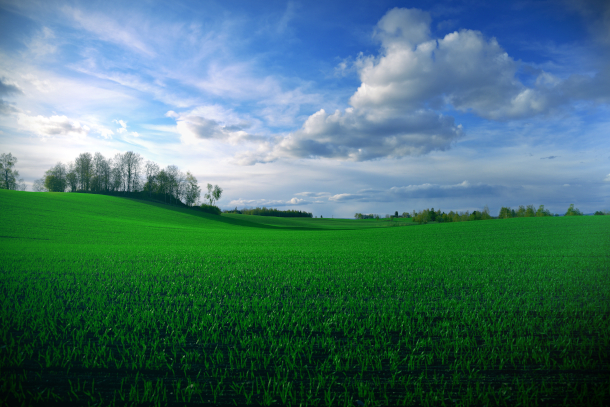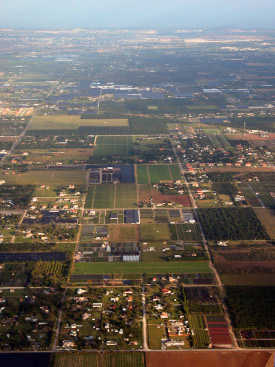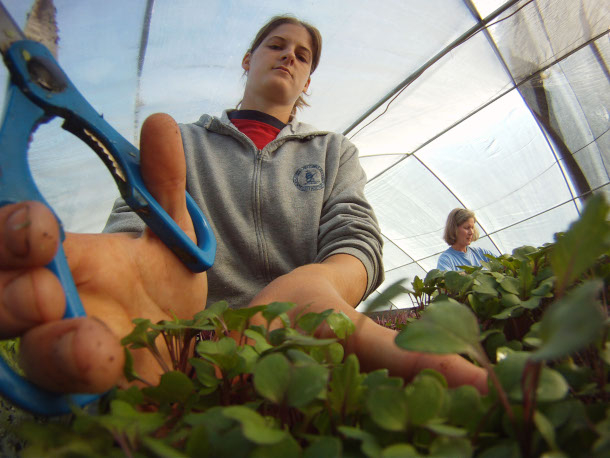Farmland Losing to Development
Air Date: Week of July 24, 2020

More than 11 million acres of U.S. farmland have been converted, fragmented or paved over by development projects in the last 20 years. (Photo: Thobias Stromberg, Flickr, CC BY 2.0)
In the last 20 years, more than 11 million acres of U.S. farmland have been converted, fragmented or paved over by development projects, according to a new report by the American Farmland Trust. Senior advisor and co-author of the report Julia Freedgood joins Steve Curwood to discuss this threat to local and regional food systems.
Transcript
BASCOMB: The U.S. has lost more than 11 million of acres of farmland over the last 20 years. Of special concern is the loss to low density residential development at the edge of urban and suburban areas. A series of studies by the American Farmland Trust show that agricultural land is being increasingly converted, fragmented, or paved over. Threatening the integrity of local and regional food systems. Julia Freedgood is a senior advisor with American Farmland Trust and a co-author the most recent report. She spoke with Living on Earth’s Steve Curwood.
CURWOOD: Just how important are local food supplies?
FREEDGOOD: I think tremendously important, quite frankly. And I think that COVID-19 has really pointed this out. You know, it's not that we need to replace the global food systems or domestic food systems. But when you have a shock, like a pandemic or an extreme weather event, the fact that you can pivot to local and regional food supplies is incredibly important for the resiliency of our food system and also to make sure that everybody in your community can get fed. I think, you know, a lot of what's driven sort of a resurgence in that kind of direct marketing is the flavor, the freshness, the quality, and also the relationship with the farmer and the transparency so that you know where your food is coming from, and you know how it's grown and you know who the people are. It's better for cooking. It's better for flavor, but it's also sort of better for building a sense of community.
CURWOOD: Tell me where should we go from here. How do the ways we get our food need to change in your opinion?

Fragmentation of farmland by development in Florida. (Photo: Art01852, Flickr, CC BY 2.0)
FREEDGOOD: I think we really need to start looking at our policy framework. I think our policy framework has served a certain portion of agriculture very well. It's very efficient. And I think efficiency is, you know, a good thing. But it's left out the majority of farms and ranches in the country. When it comes to growing food for your community, then you're competing with a global food system, prices are really low, it's very, very hard to make ends meet. Fruits and nuts and vegetables--all of those are considered specialty crops, rather than, you know, corn and soy beans and our kind of dominant agricultural production in this country. I think we need to really look at what are we going to do to make sure that we're protecting farmland in our own communities, our states and our communities? And I think we need to start looking at how do we incentivize that kind of production so that we have this kind of resiliency, so that we're ready for everything that comes whether it's a pandemic or whether it's climate change.
CURWOOD: So, talk to me about this project Farms Under Threat.
FREEDGOOD: We really wanted to look at the quality of the land for our food supply, as well as for all of agriculture. So what we were able to do was look at sort of the highest quality land in each state, and then what had happened to it in terms of development patterns. And that's where we had become aware that there was sort of this insidious pattern of sort of fragmentation in rural communities, and nobody was measuring it or tracking it. So we came up with a methodology so that we could sort of see the impact of lower density kind of development happening sort of across the countryside.
CURWOOD: In other words, sprawl.

Many of the farms threatened by low-density residential development are local, direct-to-consumer farms. (Photo: Gemma Billings, Flickr, CC BY 2.0)
FREEDGOOD: Not even as concentrated as sprawl. You know, what you'll see is one house per maybe five or 10 acres in an area, and maybe they're having some horses or some llamas or something like that, looks kind of like a farm if you're, you know, in outer space and looking down for spatial mapping. But in terms of economy, you suddenly have a different kind of an enterprise happening. It's not a commercial enterprise. And so things like the infrastructure to support agriculture, your feed stores, your supply stores, those kinds of things start to go out, and you start to get replaced by people, you know, have a couple of horses in their backyard. So it's not exactly sprawl as we think of it, you know, as urban sprawl with malls and everything around the city, but it still can have a detrimental impact on the agricultural community and economy.
CURWOOD: So tell me about these urban adjacent farms that are most threatened by development. What do these farms tend to look like and how does low density residential development affect them?
FREEDGOOD: That's such a great question because I think it's a little bit of a double edged sword. We're in New England, right? And so you see a lot of small farms kind of embedded in communities. Often these smaller farms that are metro-adjacent are doing direct to consumer marketing or supplying farmers markets and community supported ag and those kinds of things with a benefit of a population that really wants to support local farmers and local food. But I think the pressure is that there are a lot of people who already live there. There's already you know, kind of a suburb, usually a suburban economy happening. And so the pressure to develop for something other than a farm is really great and it drives land values up often beyond what a local farmer can afford to pay.
CURWOOD: And how do all your findings now fit into the current state of the of the agriculture industry?
FREEDGOOD: Well, I think that the pandemic has really sort of showed the fault lines and how overly consolidated we've become. It's not that we have a supply problem right now. What we have is a distribution problem, a supply chain problem. So you see this sort of awful juxtaposition of, you know, farmers either having to euthanize their animals or dumping milk or leaving crops unpicked, when at the same time you have these really long lines for food banks, and suddenly you have all of these people who are unemployed and food security has become a really serious issue. I hope that people are starting to take this seriously. I hope that some of the things that we've been talking about for decades about consolidation in agricultural industry and consolidation in cropland in particular, you know, farmers and ranchers and farm workers, they're essential parts of our service economy, of our labor force, right? Like, suddenly people are like, Oh my goodness, we really need to know where our food is coming from.
CURWOOD: And tell me about your experiences as the coronavirus pandemic rolled out? What was it like for you in terms of getting food where you are in Western Massachusetts, the rural part of Western Massachusetts?

Local farmers harvest shungiku microgreens in Powhatan County, Virginia. (Photo: US Department of Agriculture, Flickr, CC BY-ND 2.0)
FREEDGOOD: I would say I have felt extremely lucky. The disruption was definitely felt here too. But within a week or two, there were food deliveries. So I could just sign up online and have, you know, my spinach and carrots and onions and stuff just delivered to my house. We have local farms that have gone to, you know, curbside pickup and on-farm delivery. I'm in walking, you know, I can walk down the street and get my eggs and some meat. I ordered a pound of carrots and it came back as one carrot. So I learned something about how you order food. But I just I feel incredibly blessed to have, you know, to live in a place where we've been working on sort of local-regional food systems for a long time, and therefore we could very quickly pivot.
BASCOMB: That’s Julia Freedgood with American Farmland Trust speaking to Living on Earth’s Steve Curwood.
Links
American Farmland Trust | “Farms Under Threat: The State of States”
Atlanta Journal-Constitution | “New Report Says Georgia Farms Are Under Threat”
The Patriot-News | “Where Does Pennsylvania Rank in Farmland Loss, Protection?”
Living on Earth wants to hear from you!
Living on Earth
62 Calef Highway, Suite 212
Lee, NH 03861
Telephone: 617-287-4121
E-mail: comments@loe.org
Newsletter [Click here]
Donate to Living on Earth!
Living on Earth is an independent media program and relies entirely on contributions from listeners and institutions supporting public service. Please donate now to preserve an independent environmental voice.
NewsletterLiving on Earth offers a weekly delivery of the show's rundown to your mailbox. Sign up for our newsletter today!
 Sailors For The Sea: Be the change you want to sea.
Sailors For The Sea: Be the change you want to sea.
 The Grantham Foundation for the Protection of the Environment: Committed to protecting and improving the health of the global environment.
The Grantham Foundation for the Protection of the Environment: Committed to protecting and improving the health of the global environment.
 Contribute to Living on Earth and receive, as our gift to you, an archival print of one of Mark Seth Lender's extraordinary wildlife photographs. Follow the link to see Mark's current collection of photographs.
Contribute to Living on Earth and receive, as our gift to you, an archival print of one of Mark Seth Lender's extraordinary wildlife photographs. Follow the link to see Mark's current collection of photographs.
 Buy a signed copy of Mark Seth Lender's book Smeagull the Seagull & support Living on Earth
Buy a signed copy of Mark Seth Lender's book Smeagull the Seagull & support Living on Earth

